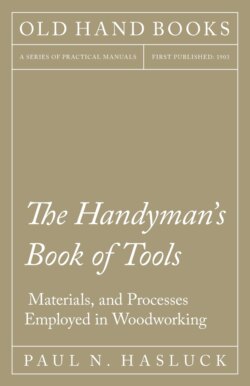Читать книгу The Handyman's Book of Tools, Materials, and Processes Employed in Woodworking - Paul N. Hasluck - Страница 67
На сайте Литреса книга снята с продажи.
OTHER VARIETIES OF PLANES.
ОглавлениеThe joiner and cabinet-maker have occasion to use many other kinds of planes, only few of which, however, require to be mentioned here. The bead plane illustrated by Fig. 174 is for the purpose of working the moulding known as a bead (this will be described later). Bead planes are made in sets, ranging from 1/8 in. to 1 in., in a set of eight. The router, or old woman’s tooth (Fig. 175), is a kind of plane used for working out the bottoms of rectangular cavities; it is used for cutting cross grooves in timber to a certain depth, particularly when the groove does not go the whole width of the stuff, as, for instance, with sinkings for treads and risers in strings. It has a broad sole, and its cutter projects the depth of the required sinking. The chariot plane (Fig. 176) is a plane used for the small parts of the work which cannot be conveniently got at with the smoothing plane. Also it is used for planing end grain and cross-grain work; the iron being very near the toe of the stock also renders the plane very useful for chamfering and for planing work recessed out of the solid. The best chariot planes are made of gunmetal, with a steel face. They are not used very much now. Chamfer planes are used for taking off sharp edges to form chamfers. There are great differences in their shapes, as may be seen from Figs. 177 to 179. Fig. 177 shows Preston’s plane, Fig. 178 Melhuish’s plane, and Fig. 179 Nurse’s plane. A mitre shooting plane is illustrated by Fig. 180, and a plough or plough plane, a most important tool, whose use will be fully described later, is shown by Fig. 181.
Fig. 174.—Bead Plane.
Fig. 175.—Router or Old Woman’s Tooth Plane.
